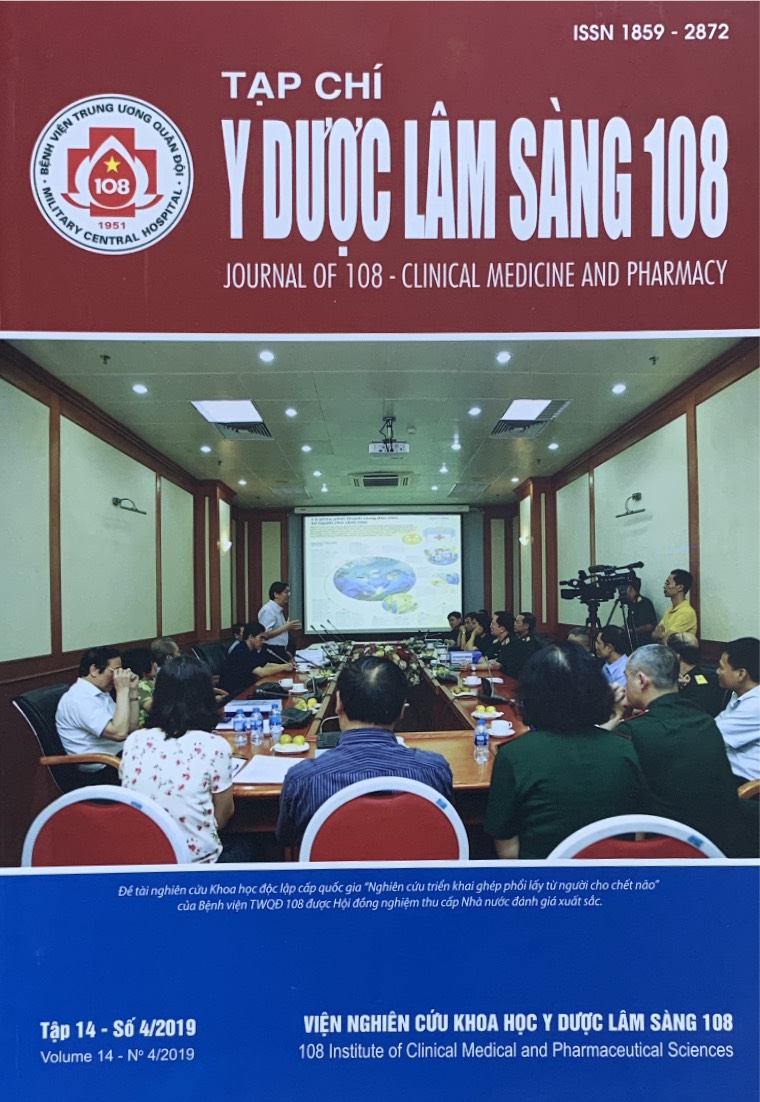Clinical, subclinical characteristics and some cytokine concentrations in patients with septic shock
Main Article Content
Abstract
Objective: To describe clinical, laboratory characteristics and some cytokine (TNF-α, IL-1b, IL-6, IL-8, and IL-10) concentrations in patients with septic shock before the time of CVVH initiation. Subject and method: 31 patients with septic shock treated at the intensive care units of Thu Duc District Hospital, 115 General Hospital and Bach Mai Hospital from January 2015 to April 2018. These patients met septic shock criteria according to Survival Sepsis Campaign (SSC) 2016. A cross-sectional study was conducted with the sample size of convenience. Patient information was documented by a standard questionnaire form. Result: The average age of the research group was 62.03 ± 15.79 years. Men accounted for 41.9%. Common chronic medical conditions were: Diabetes 19.4%, hypertension 32.3%, COPD 19.4%. Clinical manifestations were very complex, fever accounted for 80.6%, mainly mild-grade fever 52.8%. Rigor 52.0%. 100% had organ failure, liver failure was highest at 51.6%, followed by renal failure 41.9%, respiratory failure 41.9%. The mortality rate was 51.6%, the most common primary site of infection was respiratory 29.1%, followed by the GI tract 25.7%, the urinary tract 16.1%. A. baumannii was the major cause with 25.5%, followed by E. coli with 16.1%. The cytokine concentration in the study group was: TNF-α: 46.7 ± 118.28 (pg/ml), IL-6: 922.4 ± 1330.3 (pg/ml), IL-8: 724.5 ± 563.6 (pg/ml), IL-10: 99.6 ± 265.3 (pg/ml), IL-1b: 40.8 ± 128.1 (pg/ml). The concentration of cytokines in the living group was lower than the mortality group, the difference was statistically significant with p<0.05.
Article Details
References
2. Hoàng Thị Hạnh và cộng sự (2018) Đặc điểm lâm sàng và cận lâm sàng ở bệnh nhân sốc nhiễm khuẩn do vi khuẩn Gram âm điều trị tại Bệnh viện Trung ương Quân đội 108 năm 2016 - 2018. Tạp chí Y Dược lâm sàng 108, tập 13 (05), tr. 124-132.
3. Nguyễn Mạnh Hùng (2004) Nghiên cứu đặc điểm lâm sàng, cận lâm sàng và điều trị rối loạn đông máu ở bệnh nhân sốc nhiễm khuẩn. Luận văn Thạc sỹ y học, Trường Đại học Y Hà Nội.
4. Hoàng Văn Quang (2011) Nghiên cứu đặc điểm lâm sàng và kết quả điều trị suy đa tạng ở bệnh nhân sốc nhiễm khuẩn. Luận án Tiến sỹ y học, Trường Đại học Y Hà Nội.
5. Vũ Hải Yến (2012) Nghiên cứu đặc điểm lâm sàng - cận lâm sàng và kết quả của liệu pháp điều trị sớm theo mục tiêu ở bệnh nhân sốc nhiễm khuẩn. Luận văn Thạc sỹ y học, Trường Đại học Y Hà Nội.
6. Andrew Rhodes (2017) Surviving sepsis campaign: International guidelines for management of sepsis and septic shock: 2016. SCCM and ESICM.
7. Hamishehkar H et al (2010) Identification of enhanced cytokine generation following sepsis. Dream of magic bullet for mortality prediction and therapeutic evaluation. Daru 18(3): 155-162.
8. Lausevic Z et al (2008) Predicting multiple organ failure in patients with severe trauma. Can J Surg 51(2): 97-102.
9. Malak K, Thierry C (2003) Cytokines and chemokines in infectious diseases handbook. Humana Press, Inc, Totowa, New Jersey.
 ISSN: 1859 - 2872
ISSN: 1859 - 2872
